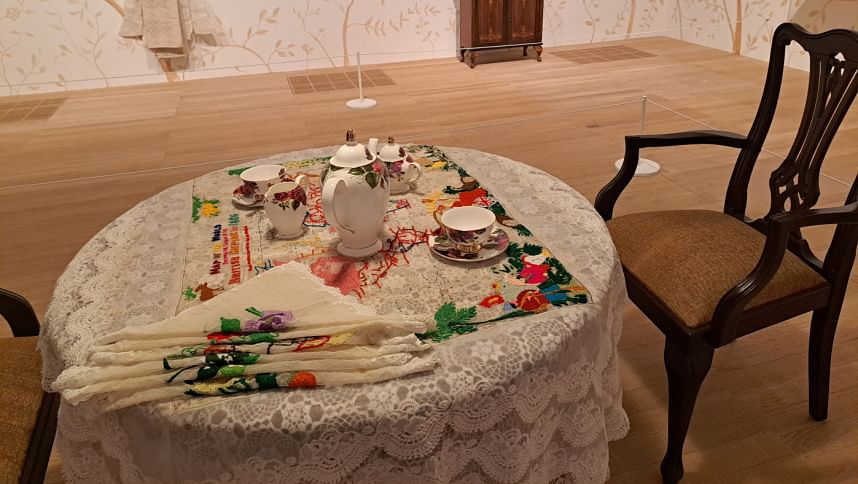A story of Tea: Yasmin Jahan Nupur dissects our British colonialist past

Yasmin Jahan Nupur's installation and performance, "Let me get you a nice Cup of Tea", is currently on display at Tate Modern. The installation has only recently been acquired for Tate's collection and will remain on view at Tate Modern till November 2023.
Nupur developed the idea behind this installation during a residency at the Peabody Essex Museum in association with Dhaka Art Summit. The Samdani Art Foundation also worked on curating this project with Nupur, which went from being an idea to a presentation in Diana Campbell's Frieze projects.
"I am very thankful to Diana, for helping me pull this off so eloquently. None of this would have been a reality without her support," asserted Nupur. "Additionally, the residency at Peabody Essex allowed me to access several South Asian archives, and greatly helped develop the post-colonial, and imperial concept behind this piece."

The first instances of the performances took place in Frieze London (2019) and the Dhaka Art Summit (2020). For ten days, during the exhibition, the artist engaged in one-on-one conversations with the guests, while providing them a cup of tea that she had grown and brewed herself.
Each session lasts around 20 minutes and dives into colonial-era subjects. "These sessions were a recreation of the British high-tea tradition, where I spent time hearing tales from each visitor while also sharing my ideas," explained the artist.
Tea has influenced societies and left a significant impact on the course of history. While emphasising tea drinking's soothing importance in Britain and South Asia, the art also invites thought on the consequences of British colonialism. Nupur's work traces the history of this beverage from Asia to Europe. The exhibit attempted to incorporate everything from the Opium Wars and the American Revolution, to the enormous migration of workers as part of plantation economics—from nurturing friendships to marriage proposals via the ritual of tea ceremonies.

As part of the performance, Nupur invites visitors into a cosy household atmosphere, yet its colonial-era design echoes the region's violent past. A Victorian-era map of the British Empire is stitched on the tablecloth and highlights the colonies that British armies captured during that time period. The napkins are stitched with opium flowers, a crop that the British East India Company forced farmers to grow, often without profit. The artist wore a 100-count white muslin jamdani, paired with an artistic blouse featuring the iconic puffed sleeves from that era, and completed her look with pearl ornaments. "The pearls are an essential representation of the British era—as a symbol of elitism," she explained.
Nupur also manages to include China into the installation, through the terracotta crockery on display. The artiste has worked closely with textile, linking tea, textile and opium to the trade lines prevalent during the 19th century. Images of tea plants have been applied to the walls using a sugar and tea mixture. This serves as a reminder of the European practice of adding milk and sugar to tea, which is an adulteration of Asian tea-drinking practices.

Yasmin Jahan Nupur began her journey as a performance artist in 2003, after being fascinated by a workshop conducted by Britto Art Trust. While she completed her education in the field of painting and drawing, she was always attracted to the theme of performance art.
"I find it to be a very present and realistic portrayal of art. The fact that the audience can associate my work with me, or simply become a part of the process is marvellous," concludes Nupur.

 For all latest news, follow The Daily Star's Google News channel.
For all latest news, follow The Daily Star's Google News channel. 








Comments